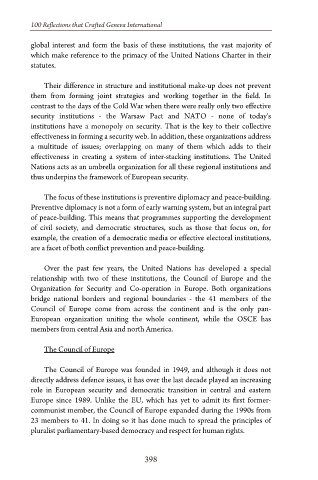Page 420 - 100 Reflections that Crafted Geneva International_V-Petrovsky_private special edition
P. 420
100 Reflections that Crafted Geneva International
global interest and form the basis of these institutions, the vast majority of
which make reference to the primacy of the United Nations Charter in their
statutes.
Their difference in structure and institutional make-up does not prevent
them from forming joint strategies and working together in the field. In
contrast to the days of the Cold War when there were really only two effective
security institutions - the Warsaw Pact and NATO - none of today's
institutions have a monopoly on security. That is the key to their collective
effectiveness in forming a security web. In addition, these organizations address
a multitude of issues; overlapping on many of them which adds to their
effectiveness in creating a system of inter-stacking institutions. The United
Nations acts as an umbrella organization for all these regional institutions and
thus underpins the framework of European security.
The focus of these institutions is preventive diplomacy and peace-building.
Preventive diplomacy is not a form of early warning system, but an integral part
of peace-building. This means that programmes supporting the development
of civil society, and democratic structures, such as those that focus on, for
example, the creation of a democratic media or effective electoral institutions,
are a facet of both conflict prevention and peace-building.
Over the past few years, the United Nations has developed a special
relationship with two of these institutions, the Council of Europe and the
Organization for Security and Co-operation in Europe. Both organizations
bridge national borders and regional boundaries - the 41 members of the
Council of Europe come from across the continent and is the only pan-
European organization uniting the whole continent, while the OSCE has
members from central Asia and north America.
The Council of Europe
The Council of Europe was founded in 1949, and although it does not
directly address defence issues, it has over the last decade played an increasing
role in European security and democratic transition in central and eastern
Europe since 1989. Unlike the EU, which has yet to admit its first former-
communist member, the Council of Europe expanded during the 1990s from
23 members to 41. In doing so it has done much to spread the principles of
pluralist parliamentary-based democracy and respect for human rights.
398

